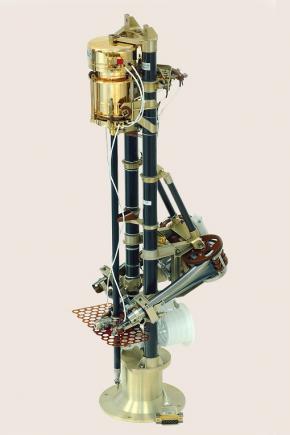WUT contribution to the Rosetta Mission
Soon, for the first time in human history, the Philae lander module of the European Rosetta mission will commence geological research on the surface of it's destination comet. It will be penetrated by MUPUS, a lander of outstanding mechanical parameters, achieved thanks to a surface engineering method developed at WUT's Faculty of Materials Science and Engineering.
The surface of the comet 67P/Czuriumow-Gierasimienko has been reached by the Philae lander of the European Rosetta Mission. This success will very soon enable geological research on the surface of the comet for the first time in history. Its surface will be penetrated by MUPUS, specially designed for microgravity operations. It was constructed in the Centre for Space Research of the Polish Academy of Sciences in Warsaw. In order to guarantee the smooth functioning of the device in the comet's environment, MUPUS construction elements underwent innovative surface machining, developed at the WUT Faculty of Materials Science and Engineering.
The MUPUS geological penetrator is an electromagnetic device designed in such a way that when its pin hits the comet surface, forces are not transferred to the lander. Many elements of the penetrator are made from a titanium alloy, a light material but of relatively low hardness. The surfaces of the elements had to have mechanical parameters necessary for devices used for geological research, so they had to be modified in a special surface machining process. Warsaw engineers proposed plasma carbonitriding.
- It should be borne in mind that the flight of the space probe to the comet took 10 years. When we were working on the elements of the space hammer, plasma carbonitriding of titanium alloys was an innovative technology all over the world – stresses prof. Tadeusz Wierzchoń, Ph.D., D.Sc., director of the Department of Surface Engineering at the WUT Faculty of Materials Science and Engineering.
As a result of carbonitriding of titanium elements of MUPUS, the surface of the machined pieces became hard, abrasion resistant, and its friction coefficient (critical for mechanical elements working in a vacuum) was low. At the same time, the created diffusive surface layer of titanium carbonitride had good surface grip.
The quality of the elements of the MUPUS penetrator machined at the WUT Faculty of Materials Science and Engineering was evaluated by independent renowned scientific institutions, e.g. Space Research Institute (Institut für Weltraumforschung, IWF) in Graz, Austria and Max Planck Institute for Aeronomy, in Lindau, Germany (now Max Planck Institute for Solar System Research).
The tradition of material science research at WUT dates back to the 20s of XX century when prof. Jan Czochralski and prof. Witold Broniewski were working at the Chemistry Department.
Currently, The Faculty of Material Science and Engineering is one of the leading scientific and research centres in Poland in this field.
Another challenge for the MUPUS constructors from the Space Research Centre of the Polish Academy of Sciences will be the necessity to integrate a fairly complicated electronic device in the small head of a penetrator which steers the sensors that are responsible for processing measurements data.
It was necessary to place the electronic devices in the head to avoid putting lots of cables between the lander module and the penetrator.
The only solution to this task was to apply specific integrated circuit (ASIC) which the constructors of the penetrator made with commercial integrated circuits such as operational amplifiers and electronic programmable logic device (EPLD).
Both Rosetta and Rosettabis were designed in WUT’s Institute of Microelectronics and Optoelectronics, both were produced and are working without any failure.
Chip Rosettabis supports two modes of the penetrator: these measure the thermal conductivity and thickness of the comet nucleus. A complementary metal–oxide–semiconductor (CMOS) sized 0,8 micrometre was produced by a multinational semiconductor manufacturer austriamicrosystems AG and still known as AMS (Austria Mikro Systeme). It was produced in 1999 with help of Europractice consortium which gives academics access to professional EDA software, industrial microelectronic technologies and provides funding for prototypes of integrated circuits. The cost of the production of Rosettabis was ca. 2800 euro. It was designed by dr Zbigniew Jaworowski - member of the Design Methods in Microelectronics Team.


